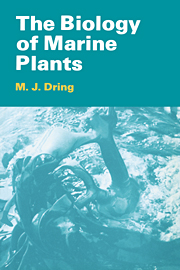Book contents
- Frontmatter
- Contents
- PREFACE
- ACKNOWLEDGEMENTS
- 1 MARINE PLANTS: TAXONOMIC, MORPHOLOGICAL AND ECOLOGICAL CATEGORIES
- 2 THE SEA AS AN ENVIRONMENT FOR PLANT GROWTH
- 3 PHOTOSYNTHESIS IN THE SEA
- 4 GROWTH AND PRODUCTIVITY OF MARINE PLANTS
- 5 MORPHOGENESIS OF MARINE PLANTS
- 6 THE ECOLOGY OF SEAWEEDS: ZONATION AND SUCCESSION
- 7 GEOGRAPHICAL DISTRIBUTION OF MARINE PLANTS
- 8 USES AND USAGE OF MARINE PLANTS
- 9 BACTERIA AND FUNGI IN THE SEA
- REFERENCES
- INDEX
6 - THE ECOLOGY OF SEAWEEDS: ZONATION AND SUCCESSION
Published online by Cambridge University Press: 02 February 2010
- Frontmatter
- Contents
- PREFACE
- ACKNOWLEDGEMENTS
- 1 MARINE PLANTS: TAXONOMIC, MORPHOLOGICAL AND ECOLOGICAL CATEGORIES
- 2 THE SEA AS AN ENVIRONMENT FOR PLANT GROWTH
- 3 PHOTOSYNTHESIS IN THE SEA
- 4 GROWTH AND PRODUCTIVITY OF MARINE PLANTS
- 5 MORPHOGENESIS OF MARINE PLANTS
- 6 THE ECOLOGY OF SEAWEEDS: ZONATION AND SUCCESSION
- 7 GEOGRAPHICAL DISTRIBUTION OF MARINE PLANTS
- 8 USES AND USAGE OF MARINE PLANTS
- 9 BACTERIA AND FUNGI IN THE SEA
- REFERENCES
- INDEX
Summary
Seaweeds are not simply plants that live in the sea: they are morphologically and physiologically distinct from both land plants and the majority of freshwater algae (see Chapter 1). The detailed study of the relationships between these plants and their natural environment may, therefore, provide some clues about why seaweeds are so different from the plants of other habitats. Rocky shores and solid substrates down to the lower limit of the photic zone provide the main habitat for seaweeds, and this habitat, in itself, is of interest to plant ecologists because of the large variations in the degree of disturbance and stress that may occur within relatively small areas. Disturbance is used here to refer to factors, such as wave action and grazing, which limit plant biomass by causing its partial or total destruction, whereas stress is used as a collective term for the external factors which limit the rate of dry matter production by plants. It is excessive disturbance which prevents seaweeds from colonizing mud, sand or shingle, and which restricts their development on wave-beaten rocks, but the limits to the vertical distribution of seaweeds on sheltered rocky shores are largely imposed by the stresses associated with emersion at the top of the shore, and by low light at the bottom of the photic zone. Between these two extremes, and especially in the upper part of the subtidal zone, the intensities of both stress and disturbance may be low, and conditions are then particularly favourable for plant growth (see p. 85).
- Type
- Chapter
- Information
- The Biology of Marine Plants , pp. 119 - 138Publisher: Cambridge University PressPrint publication year: 1991

